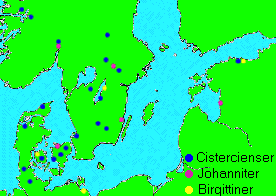Meet the Middle Ages
BackMonasteries and nunneries

The monasteries and nunneries were important establishments in medieval society. Here, the monks and nuns lived, devoting their lives to God and helping their fellow human beings. At certain hours of the day - the canonical hours - they prayed, sang or read from the Bible. Every day, Holy Mass was said. Between the services there was work to be done. The motto was "Ora et labora" - pray and work.
The monks and the nuns could do all kinds of work. They might work in their gardens, or make transcriptions of holy scriptures in the library. The nuns were often good at sewing and needle-point. The monks helped people who came to the monastery. They wrote letters or answered questions about legacies, deeds or wills.
A convent was also a kind of hospital. The monks and the nuns often knew how to take care of people who were ill.
Sometimes, important political meetings were held at the monasteries. There would be a large assembly hall where these gatherings took place. The monks took the decisions down in writing. At the convent, there were also lodgings for travellers. These were available to rich and poor alike.
The monks and nuns belonged to different orders. In the Nordic countries, there were monasteries of the Cistercian order, the Order of St. Benedict, the Order of St. Birgitta and the Order of St. John. Every order had its own traditions and rules, but all monks and nuns shared the vows of poverty, chastity and obedience.